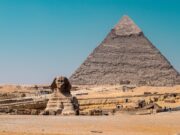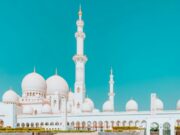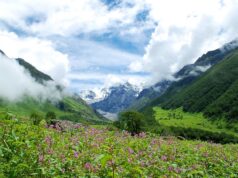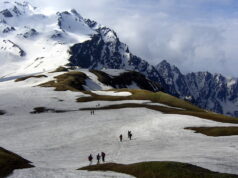Travelling is for sure an alluring activity, but comes with bottleneck decisions too. Oh yes, the most difficult of them being is choosing what destination to travel too. Some people might have weakness for serene lakes, some for roaring beaches, some for sturdy mountains, some for historical ruins, and some just live to travel. Nevertheless how far you bottom down your likeness, Travelling will always throw this decision making of destination on you. But we are glad that resources like Michelin Stars, UNESCO World Heritage Sites, have made our life easier. So here we are with UNESCO World Heritage Cultural Sites in India you must travel to.
Agra Fort – Gardens of Taj Mahal is not where beauty ends, but it is the start of this Grandeur Imperial Palace of Mughals, the Red Fort of Agra. When Disney was Light Years away from imagination, Red Fort encompassed beauties such as Jahangir Palace, Khas Mahal, Diwan-i-Khas.
Ajanta Caves – If you always though that caves were dark and creepy, you must visit this beauty on rocks. It has paintings and sculptures that were neither one day nor one man work. It is made of Buddhist Religious arts and considered to be a landmark work.
NalandaMahavihara – Ruins that were once the high seat of education. This monastic and Scholastic institution dates back to Before Christ. It has Stupas, Shrines, Viharas, and artworks made of stone and metal. It is considered to be instrumental in propagation of Buddhism, and Monastic beliefs.
Buddhist Monuments at Sanchi – A little far from the city of Bhopal, is a little paradise of historic arts that consists of Monolithic Pillars, Palaces, Temples, and Monasteries, all of which dates back to Before Christ. It has also been a significant centre of Buddhism in past.
ChampanerPavagadh Park – Perfected by hilly landscape and prehistoric chalcolithic sites as backdrop this living historic and fortified beauty encloses palaces, religious buildings, and water installations. Kalikamata temple of Pavagadh is a huge attraction for pilgrims from across the nation.
ChhatrapatiShivaji Terminus – This is the place where you not only can catch a train but Victorian Gothic Revival Architecture too. It has remarkable stone domes, turrets, distinguished arches, that are perfect blend of Indian and Gothic Culture.
Churches and Convents of Goa – Besides beautiful beaches, Goa is also home to Portuguese styled Churches. Particularly Church of Bom Jesus is significant one that was instrumental in evangelization of Asia. Church of St. Cajetan and Church of St. Francis of Assisi too are remarkable.
Elephanta Caves – The beauty resides on an island close by to Metropolitan city of Mumbai. Its collection of rocks is of Shiva Cult. It has few similarities to that of Ellora Caves. The sculptural art of Elephanta has its own significance and represents innovation of their times.
Ellora Caves – This one is a masterpiece serially carved out of a Basalt Cliff with number of monuments. Artistic influence of this place is very high. It also has sanctuaries related to Hinduism, Buddhism, and Jainism altogether that signifies the religious tolerance of ancient India.
Fatehpur Sikri – The City of Victory that also had the privilege of serving as Capital of Mughals though for a short period of time, is popular for its uniformity in Architectural style, monuments and temples. Some of them are Jama Masjid, and Diwan-i-Khas.
Chola Temples – These are the living historical temples build by Chola Empire. The eminent ones are Brihadisvara Temple and Airavatesvara Temple. The latter has a popular stone image of Lord Shiva. These temples signify the architectural, artistic heights of Chola Empire in Sculpture, Paintings and Bronze Casting.
Monuments at Hampi – The grandeur Hampi was last capital of Hindu Kingdom of Vijayanagar. The rich princes had got built fabulous Dravidian temples and palaces that got later plundered by Deccan Muslim confederacy. Krishna Temple, Narsimha, Ganesa Temples are remarkable works here.
Monuments at Mahabalipuram – Pallava Kings brought these beauties to life by craving out of rocks. The grandeur of these monuments consists of Temples in form of Chariots, and cave sanctuaries. The Temple of Rivage with thousand sculptures of Lord Shiva is its true highlight.
Monuments at Pattadakal – Chalukya Kings were behind this artistic blend of Northern and Southern architecture carved in nine Hindu temples and a Jain sanctuary. These are mesmerizing pieces of arts that can spell bound anyone.
Hill Forts of Rajasthan – The six majestic forts situated at Chittorgarh, Kumbhalgarh, SawaiMadhopur, Jhalawar, Jaipur, and Jaisalmer, are no less grandeur than the other. They symbolize once might of Rajputs. Enclosed within the fortification are beautiful palaces, temples, complexes. These little worlds are worth the sight of how the fort life was.
Humayun’s Tomb – Also called Dormitory of Mughals, as it is also tomb to other 150 Mughals, was the first ever garden mausoleum on Indian Sub-continent that later also gave inspiration to Taj Mahal. It has both Persian and Indian Influence in its Architectural style.
Khajuraho Monuments – They are popular for Nagarastyle architectural symbolism and their erotic sculptures. Now only 20 of the temples remain. It has mixed religious roots of Hinduism and Jainism. The temple of Kandariya is considered to have one of best masterpieces of Indian Arts.
Mahabodhi Temple – It is a holy site related to life of Lord Buddha, particularly to attainment of enlightenment. Built by Emperor Asoka, it means the Great Awakening Temple. It attracts pilgrims and devotees from all across India and World.
QutbMinar – This red sandstone tower has angular and rounded flutings. The surrounding buildings consist of Alai Darwaza a masterpiece of Indo Muslim Art and another landmark mosque Quwwatu’l-Islam which was made of material reused by some 20 Brahman temples.
Rani-ki-Vav – On contrary to the name, it was built as a memorial to a King. It is a stepwell that is distinguished form of storage system in Indian sub-continent. It has a MaruGurjara architectural style with seven levels of stairs and over 500 sculptures with great details. The artistic theme is well diverse around Religious, Mythological and secular imagery.
Red Fort Complex –It was built as a palace of Fort Shahjahanbad that also served as a Capital of Mughals. It derives the name after the great walls of fort made of Red sandstone. It is connected along with water channels called Nahr-i-Behisht. The architecture is blend of Persian, Timurid and Hindu traditions. Every Independence day the Indian Tri Colour is hosted here by the PM.
Rock Shelters of Bhimbetka – It is situated at foothills of Vindhyan Mountains. It consists of five clusters of natural rock shelters, with paintings dating back to Mesolithic Period. It is a living testament of pre historic times and an evidence of their intelligence.
Sun Temple – This one rises on the side of Sun. Built as a representation of Sun God Surya’s Chariot with 24 wheels artistically sculpted and led by team of six horses. Also called as Black pagoda byu Europeans, this temple stands tall as symbol of Religious beliefs.
Taj Mahal – If India is better known for something beautiful it is Taj Mahal.Love is eternal and so is tryst of people with Taj Mahal. One of Seven wonders and there is none of its kind. Built in the memory of Mughal Queen, the artistic blend of this monument is best of Indian sub-continent.
The JantarMantar, Jaipur – It was built for astronomical observation where monuments of complex are instruments in itself with observation visible to naked eyes. It signifies the importance of science post Mughal Period in India. It is one of the best preserved observatories.
Heritage is your Right!









































